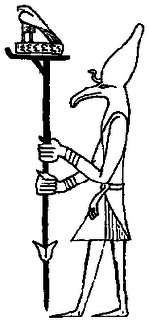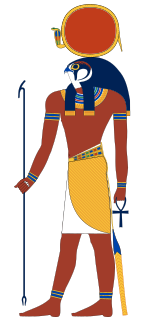
Ninḫursaĝ, also known as Damgalnuna or Ninmah, was the ancient Sumerian mother goddess of the mountains, and one of the seven great deities of Sumer. She is principally a fertility goddess. Temple hymn sources identify her as the "true and great lady of heaven" and kings of Sumer were "nourished by Ninhursag's milk". Sometimes her hair is depicted in an omega shape and at times she wears a horned head-dress and tiered skirt, often with bow cases at her shoulders. Frequently she carries a mace or baton surmounted by an omega motif or a derivation, sometimes accompanied by a lion cub on a leash. She is the tutelary deity to several Sumerian leaders.

Nut, also known by various other transcriptions, is the goddess of the sky in the Ennead of ancient Egyptian religion. She was seen as a star-covered nude woman arching over the earth, or as a cow.

Atum, sometimes rendered as Atem or Tem, is an important deity in Egyptian mythology.

Tefnut is a deity of moisture, moist air, dew and rain in Ancient Egyptian religion. She is the sister and consort of the air god Shu and the mother of Geb and Nut.

Amunet is a primordial goddess in ancient Egyptian religion.
In ancient Egypt, the name Mehen, meaning 'coiled one', referred to a mythological snake-god and to a board game.
Heka was the deification of magic and medicine in ancient Egypt. The name is the Egyptian word for "magic". According to Egyptian literature, Heka existed "before duality had yet come into being." The term ḥk3 was also used to refer to the practice of magical rituals.
Andjety is a local ancient Egyptian deity of the ninth nome, centered at Andjet, which was known as Busiris to the Greeks. This deity is also known by the alternative names Anezti or Anedjti. Andjety is considered one of the earliest Egyptian gods, possibly with roots in prehistoric Egypt.

Ash was the ancient Egyptian god of oases, as well as the vineyards of the western Nile Delta and thus was viewed as a benign deity. Flinders Petrie in his 1923 expedition to the Saqqara found several references to Ash in Old Kingdom wine jar seals: "I am refreshed by this Ash" was a common inscription.
Asherah, in ancient Semitic religion, is a mother goddess who appears in a number of ancient sources. She appears in Akkadian writings by the name of Ašratu(m), and in Hittite as Aserdu(s) or Asertu(s). Asherah is generally considered identical with the Ugaritic goddess ʼAṯirat (Athirat).
Iusaaset or Iusaas is a primordial goddess in Ancient Egyptian religion. In Egyptian texts, she is described as "the grandmother of all of the deities". This allusion is without any reference to a grandfather, so there might have been a very early, but now lost, myth with parthenogenesis as the means of the birth of the deities from the region where her cult arose near the delta of the Nile. There are many alternative spellings of her name, including Iusaaset, Iusaas, Juesaes, Ausaas, and Jusas, as well as in Greek Saosis.

Ancient Egyptian deities are the gods and goddesses worshipped in ancient Egypt. The beliefs and rituals surrounding these gods formed the core of ancient Egyptian religion, which emerged sometime in prehistory. Deities represented natural forces and phenomena, and the Egyptians supported and appeased them through offerings and rituals so that these forces would continue to function according to maat, or divine order. After the founding of the Egyptian state around 3100 BC, the authority to perform these tasks was controlled by the pharaoh, who claimed to be the gods' representative and managed the temples where the rituals were carried out.

Werethekau was an Ancient Egyptian deity. She served as the personification of supernatural powers.

Ra or Re is the ancient Egyptian deity of the sun. By the Fifth Dynasty in the 25th and 24th centuries BC, he had become one of the most important gods in ancient Egyptian religion, identified primarily with the noon sun. Ra was believed to rule in all parts of the created world: the sky, the Earth, and the underworld.
A deity is a supernatural being considered divine or sacred. The Oxford Dictionary of English defines deity as "a god or goddess ", or anything revered as divine. C. Scott Littleton defines a deity as "a being with powers greater than those of ordinary humans, but who interacts with humans, positively or negatively, in ways that carry humans to new levels of consciousness, beyond the grounded preoccupations of ordinary life". In the English language, a male deity is referred to as a god, while a female deity is referred to as a goddess.

The Cavern deities of the underworld were ancient Egyptian minor deities charged with punishing the damned souls by beheading and devouring them.

The Gate deities of the underworld were ancient Egyptian minor deities charged with guarding the gates of the Egyptian underworld.

The Assessors of Maat were 42 minor ancient Egyptian deities of the Maat charged with judging the souls of the dead in the afterlife by joining the judgment of Osiris in the Weighing of the Heart.












